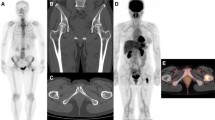Abstract
Purpose
The aim of this study is to specify the precise role of bone scintigraphy and serum CEA and CA 15-3 assays in the monitoring of breast cancers in order to optimize their use and to determine whether it is possible to guide the prescription of bone scan by the use of CEA and CA 15-3 assays in the monitoring of breast cancer.
Methods
For this purpose, from November 1997 to May 2002, 98 consecutive female breast cancer patients (median age, 52 years; range 35-77 years) underwent bone scintigraphy during follow-up. In these patients values of tumor markers were compared with the results of bone scintigraphy. Some of the patients with bone metastasis were checked repeatedly at intervals of 6 to 12 months, resulting in 49 patients with bone metastasis and 74 patients without bone metastasis being included in the study.
Results
In patients with bone metastasis, serum CEA levels were abnormal in 23/49 cases and CA 15-3 serum concentrations were elevated above the cut-off in 33/49 cases. Among patients without bone metastasis, CEA and CA 15-3 serum concentrations were normal in 50/74 and 55/74 cases respectively. The combination of the two markers improved the diagnostic sensitivity.
Conclusion
Although serial tumor marker measurements are an efficient and cost effective method of monitoring disease progression, it does not allow prediction of the bone scan results; so it is not justifiable to reject a bone scintigraphy on the basis of these markers.
Similar content being viewed by others
References
Coleman RE, Rubens RD. The clinical course of bone metastasis from breast cancer.Br J Cancer 1987; 55:61–66.
Coleman RE, Rubens RD, Fogelman I. Reappraisal of the baseline bone scan in breast cancer.J Nucl Med 1988; 29:1045–1049.
Crippa F, Bombardieri E, Seregni M, et al. Single determination of CA 15.3 and bone scintigraphy in the diagnosis of skeletal metastasis of breast cancer.J Nucl Biol Med 1992; 36:52–55.
Nicolini A, Ferrari P, Sagripanti A, Carpi A. The role of tumour markers in predicting skeletal metastasis in breast cancer patients with equivocal bone scintigraphy.Br J Cancer 1999; 79:1443–1447.
Zanco ?, Rota G, Sportiello V, et al. Diagnosis of bone and liver metastasis in breast cancer comparing tumor markers and imaging techniques.Int J Biol Markers 1989; 4:103–105.
O’Brien DP, Horgan PG, Gough DB, et al. CA 15-3: a reliable indicator of metastatic bone disease in breast cancer patients.Ann R Coll Surg Engl 1992; 74:9–11.
Kokko R, Holli K, Hakama M. Ca 15-3 in the follow-up of localised breast cancer: a prospective study.Eur J Cancer 2002;38:1189–1193.
Forest JC, Masse J, Lane A. Evaluation of the analytical performance of the Boehringer Mannheim Elecsys 2010 immunoanalyzer.Clin Biochem 1998; 31 (2):81–88.
Koizumi M, Yamada Y, Takiguchi T, et al. Bone metabolic markers in bone metastasis.J Cancer Res Clin Oncol 1995; 121:542–548.
Tubiana-Hulin M. Incidence, prevalence and distribution of bone metastasis.Bone 1991; 12:9–10.
Cook GJR, Fogelman I. Skeletal metastasis from breast cancer: Imaging with Nuclear Medicine.Semin Nucl Med 1999; 29:69–79.
Clinical practice guidelines for the use of tumor markers in breast and colorectal cancer. Adopted on May 17, 1996 by the American Society of Clinical Oncology.J Clin Oncol 1996; 14:2843–2877.
Safi F, Kohler I, Rottinger E, Beger H. The value of the tumor marker CA 15-3 in diagnosing and monitoring breast cancer. A comperative study with carcinoembryonic antigen.Cancer 1991; 68:574–582.
Buffaz PD, Gauchez AS, Caravel JP, et al. Can tumor marker assays be a guide in the prescription of bone scan for breast and lung cancers?Eur J Nucl Med 1999; 26:8–11.
Younsi N, Montravers F, Philippe C, et al. CA 15-3 and bone scintigraphy in the follow-up of breast cancer.Int J Biol Markers 1997; 12:154–157.
Author information
Authors and Affiliations
Corresponding author
Rights and permissions
About this article
Cite this article
Yildiz, M., Oral, B., Bozkurt, M. et al. Relationship between bone scintigraphy and tumor markers in patients with breast cancer. Ann Nucl Med 18, 501–505 (2004). https://doi.org/10.1007/BF02984567
Received:
Accepted:
Issue Date:
DOI: https://doi.org/10.1007/BF02984567




